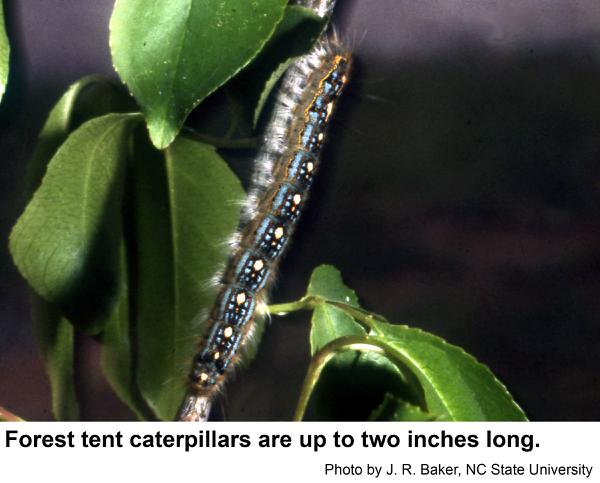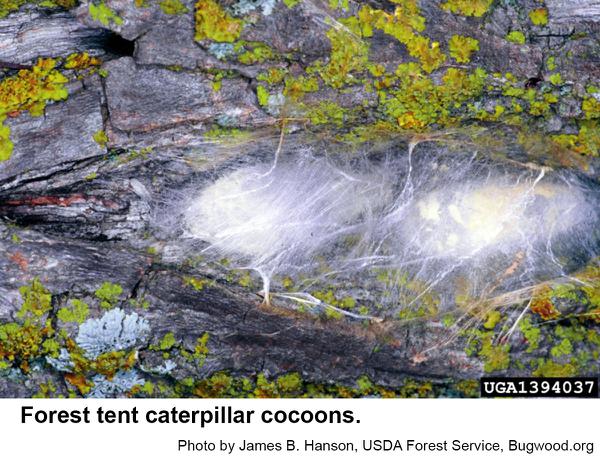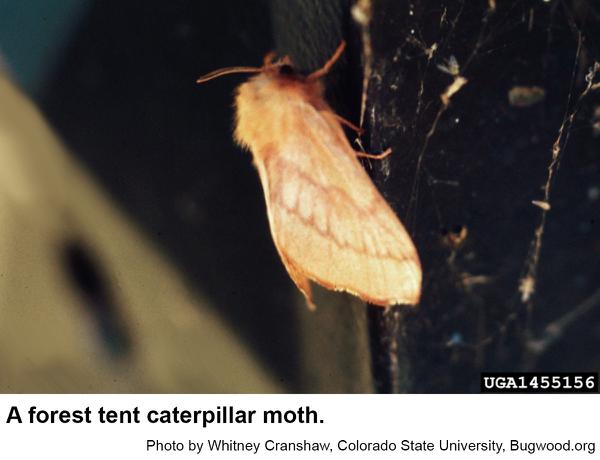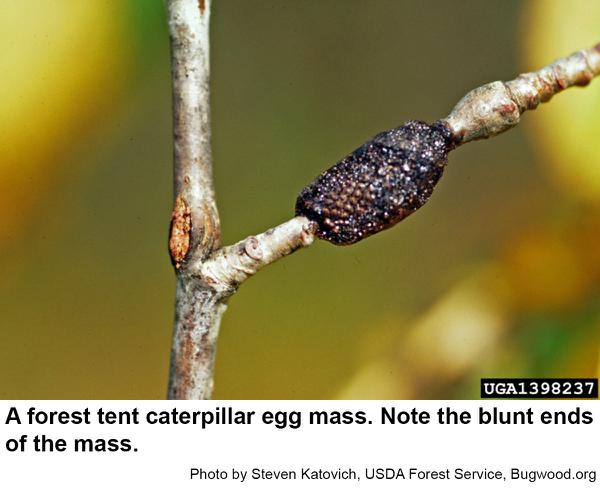Description and Biology
Forest tent caterpillars, Malacosoma disstria, have one generation a year. Young larvae appear in spring just as leaves are beginning to unfold. New caterpillars are nearly uniformly black, are less than 1/8 inch long, and have conspicuous hairs. Forest tent caterpillars form colonies that move about in a line, following silk trails laid down by leaders. With each successive molt, markings of pale bluish lines along the sides of a brownish body and a top row of footprint- or keyhole-shaped, white spots down the back. Caterpillars grow to about 2 inches long. Although they are called tent caterpillars, they do not spin a tent. They form a silken mat on the bark where they congregate when resting or molting. During their early stages, they congregate in the upper part of the tree. Later they congregate lower in the tree and on the trunk. Larvae usually pass through five stages. When high populations result in complete tree defoliation, older caterpillars often crawl about in search of food or a suitable place for spinning cocoons. Their tendency to crawl in single file has caused them to be called "armyworms" by some. Five or six weeks after hatching, the caterpillars spin yellow cocoons of silk colored in a folded leaf, bark crevice, or other sheltered place. In these cocoons, the larvae molt into pupae. Buff-brown moths emerge about 10 days later and live for only a few days during which they mate and females lay eggs. The forewings have two darker oblique lines near the middle. Forest tent caterpillar moths are attracted to lights. The eggs are laid mostly around upper small twigs in masses of 100 to 350. The eggs are cemented together and are coated witb a frothy secretion that hardens and turns a glossy dark brown. Within 3 weeks the embryos develop into tiny caterpillars that remain inside the eggs through the winter to hatch the following spring.
Host Plants
Forest tent caterpillars feed on a variety of broadleaved trees and shrubs although in North Carolina they seem to be most abundant on oaks and sweet gum, black gum, and tupelo. Other tree species fed upon include birch, cherry, basswood, and ash. After they have stripped trees, the caterpillars feed on shrubs and even vegetables.
Residential Recommendations
Although forest tent caterpillars can cause extensive defoliation, this injury occurs in spring. Our growing season is so long here in North Carolina, that most trees defoliated in spring recover sufficiently without long term harm. However, extensive defoliation two or three years in a row may cause stunting and dieback. During most years, parasites, predators (especially birds), and diseases keep forest tent caterpillars below a nuisance level. Should infested trees of high value to the landscape be small enough to spray and should the damage be enough to cause alarm, most of the insecticides labeled for residential landscape use will control all but the largest caterpillars that are just before spinning their cocoons. Bacillus thuringiensis insecticides are effective against very young forest tent caterpillars, but not against older worms.
References
- Forest Tent Caterpillar. Batzer, H. O. and R. C. Morris. 1978 (revised). Forest Insect & Disease Leaflet 9. USDA Forest Service.
- Common name: forest tent caterpillar, scientific name: Malacosoma disstria Hübner (Insecta: Lepidoptera: Lasiocampidae). Meeker, J. 2013 (revised). Featured Creatures, Entomology & Nematology, FDACS/DPI, EDIS. Publication Number: EENY-184.
- Extension Plant Pathology Publications and Factsheets
- Horticultural Science Publications
- North Carolina Agricultural Chemicals Manual
For assistance with a specific problem, contact your local N.C. Cooperative Extension Center.
This Factsheet has not been peer reviewed.
Publication date: Oct. 7, 2016
Reviewed/Revised: Sept. 17, 2019
Recommendations for the use of agricultural chemicals are included in this publication as a convenience to the reader. The use of brand names and any mention or listing of commercial products or services in this publication does not imply endorsement by NC State University or N.C. A&T State University nor discrimination against similar products or services not mentioned. Individuals who use agricultural chemicals are responsible for ensuring that the intended use complies with current regulations and conforms to the product label. Be sure to obtain current information about usage regulations and examine a current product label before applying any chemical. For assistance, contact your local N.C. Cooperative Extension county center.
N.C. Cooperative Extension prohibits discrimination and harassment regardless of age, color, disability, family and marital status, gender identity, national origin, political beliefs, race, religion, sex (including pregnancy), sexual orientation and veteran status.




